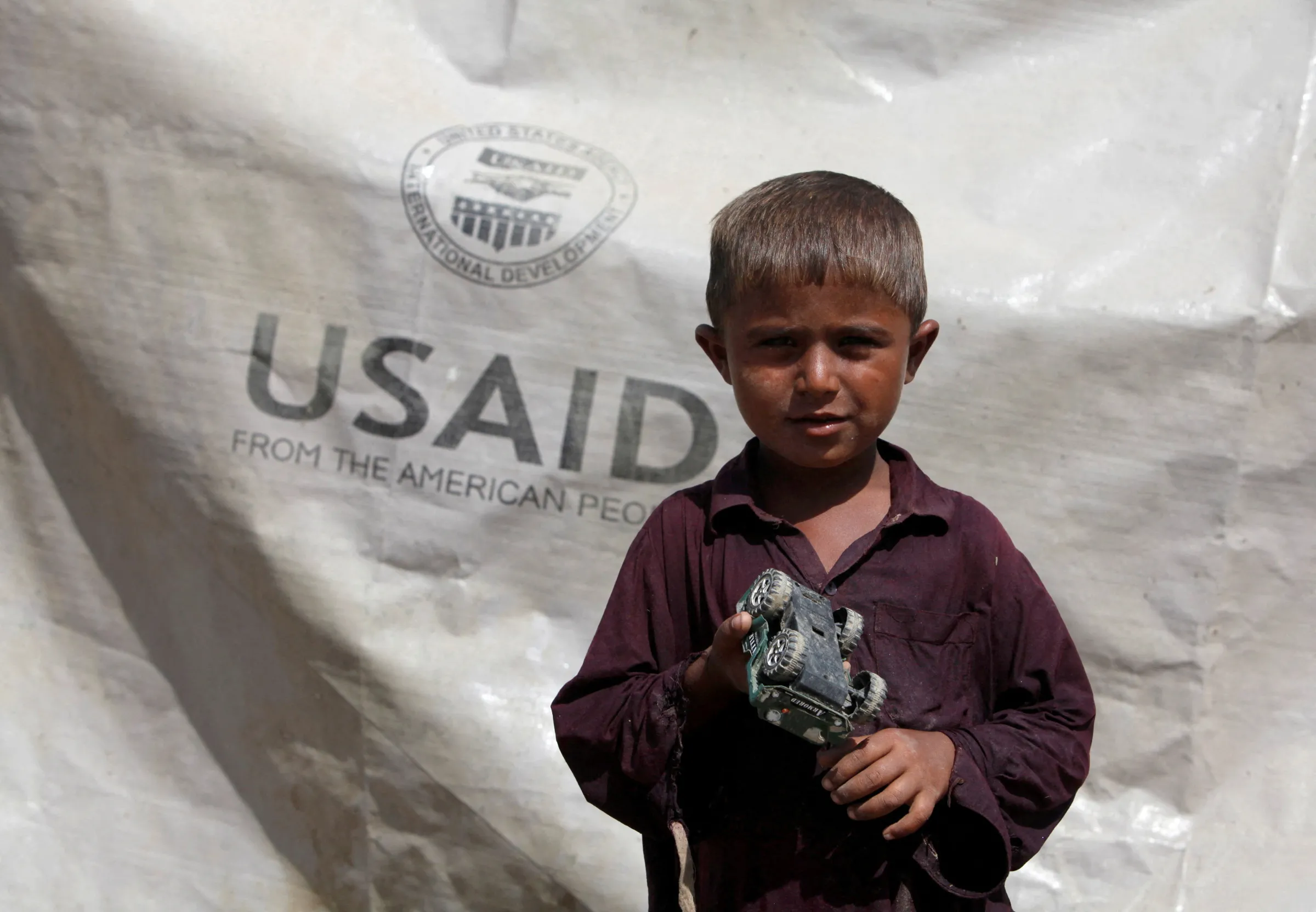Context is powered by the Thomson Reuters Foundation Newsroom.
Our Standards: Thomson Reuters Trust Principles

A boy who has been displaced by flooding, holds his toy jeep outside his family tent with the weather sheet donated by USAID in Pakistan's Sindh province October 5, 2010. REUTERS/Akhtar Soomro
Trump's freeze on USAID has left millions without life-saving help. Where does the money go and what has been the global impact?
NAIROBI – U.S. President Donald Trump's decision to freeze foreign aid has abruptly halted hundreds of life-saving programmes around the world, from malaria prevention in Kenya, to HIV treatment in Myanmar.
Trump announced the 90-day pause in the disbursement of billions of dollars from the U.S. Agency for International Development (USAID) on Jan. 20 in order to assess whether aid allocation aligned with his "America First" agenda.
U.S. Secretary of State Marco Rubio said "life-saving humanitarian assistance" would be exempt from the freeze, but aid workers are grappling to secure waivers, partly due to thousands of USAID's workforce being put on leave.
A U.S. judge has temporarily allowed roughly 2,700 USAID staff who were put on leave by Trump's administration to return to work until Feb. 14. Federal employee unions have accused the administration of violating the court order.
Billionaire Elon Musk, tasked with slimming down federal government, has said he wants to shut down USAID, calling it "beyond repair".
Here's what you need to know about where USAID funds go and how people across the world are being affected by the freeze.
The United States is the biggest spender on international development in the world, followed by Germany, the European Union, Japan, Britain, France and Canada.
Government data shows the U.S. spent $68 billion on international aid in 2023. The funds are spread across several departments and agencies, but USAID's budget constituted more than 60% of the spending at around $42 billion.
Yet, while the United States gives more official government aid than any other country, its contribution as a percentage of national income is at the bottom of the list for wealthy countries, according to the Organization for Economic Co-operation and Development.
In 2023, Norway topped the list at 1.09% of gross national income, while the United States lagged at 0.24%, along with Slovenia, the Czech Republic and Spain.
USAID funds were spent across 157 countries in 2023. Ukraine was the top recipient, with more than $16 billion - nearly 40% of the $42 billion budget - being allocated to the country.
Other major recipients were Ethiopia, Jordan, the Democratic Republic of Congo, Somalia, Yemen, Afghanistan, Nigeria, South Sudan and Syria.
USAID funds more than 6,000 global programmes in health, education, climate change, food security, humanitarian assistance, governance and democracy.
Health
USAID supports PEPFAR for HIV/AIDS prevention and treatment, mainly in Africa. It also funds initiatives against malaria, tuberculosis and severe malnutrition. It also supports vaccine development and women's reproductive health.
Democracy and Governance
Some 38% of USAID's budget promotes democracy and human rights, with more than $14 billion allocated in 2023, focusing on Ukraine. Projects strengthen media, civil society and anti-corruption efforts.
Humanitarian Assistance
In 2023, 22% of funds addressed humanitarian crises in countries like Sudan and Ukraine, providing food, water, shelter and long-term nutrition services.
Climate Change and Food Security
USAID collaborates to develop climate solutions, improve land management, and invest in renewable energy. In Colombia, it enhances climate resilience and promotes climate-smart agriculture.
Education
USAID supports teacher training, school management and scholarships, with initiatives to increase girls' school enrolment in countries like Mozambique and Nepal.
Aid workers say the freeze has forced hundreds of life-saving programmes to come to a halt overnight and left millions of the world's most vulnerable people at grave risk.
A Burmese refugee with lung problems died after she was discharged from a U.S.-funded hospital on the Myanmar-Thai border that was ordered to close as a result of the freeze.
Humanitarian organisation Doctors of the World said it had closed more than half of its hospitals in northern Syria, affecting 9,000 patients monthly.
Some 20,000 people in the Democratic Republic of Congo, where thousands have been displaced by conflict, will lose access to essential medication, and at least 7,000 children under five will no longer be screened for severe acute malnutrition, Doctors of the World said.
Humanitarian agency the Norwegian Refugee Council (NRC) said it had had to suspend ongoing and urgent work in nearly 20 countries.
In Ukraine, the NRC has had to halt the distribution of emergency support to 57,000 people in communities along the frontlines, just as winter takes full hold, leaving people unable to heat their homes or get vital goods such as food.
The NRC said it was also forced to lay off aid workers, including female and male staff in Afghanistan who sustain a faltering lifeline to girls, women and families following the chaotic departure of U.S. and other NATO troops in 2021.
ILGA World, a global network of more than 2,000 LGBTQ+ organisations, said it had lost crucial support for its research and monitoring programmes in regions like the South Pacific and Caribbean.
Civil society organisations have launched surveys asking grassroots groups to report back on the impact of the freeze on local communities, and have also established trackers to monitor the effect globally.
(Reporting by Nita Bhalla; Additional reporting by Lucy Middleton and Diana Baptista; Editing by Jon Hemming.)
Context is powered by the Thomson Reuters Foundation Newsroom.
Our Standards: Thomson Reuters Trust Principles